Finnegan’s Wake – The Music

Unlike the lyrics, which were written from scratch around 1860, the music of Finnegan’s Wake was adapted from traditional Irish melodies. Of the three early versions which I have identified, only one—the Poole Version—identifies the source music:
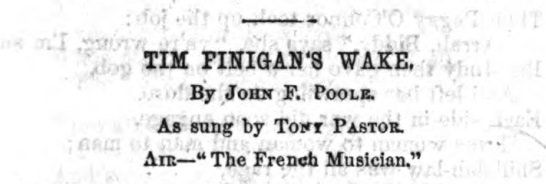
The Traditional Tune Archive has more information on this subject:
FINNEGAN’S WAKE (Tórraṁ Uí Finnguine). AKA - Tim Finnegan’s Wake. AKA and see Bhean Spáinneach (An) [The Spanish Lady], Doran’s Ass, French Musician (The), Paddy Doyle, Spanish Lady (The). Irish, New England; Air (cut time), Polka or March (2/4) ... A tune derived from a comic “stage-Irish” song, which Bayard (1981) says was known in Pennsylvania as a folk song called Dolan’s Ass. The first part of the tune, he observes, is perhaps older than the second. The sheet music was listed as published in New York by Wm. A. Pond Co. in 1864, while a different reference from the same year names the air to the song as The French Musician. The Journal of the Folk Song Society, vol. IV, p. 294, gives three sets of the air, two from the early 18th century and one from camp meeting spirituals known in Britain and the U.S. (all sets resemble the first strain of Finnegan’s Wake). The song Willie Taylor is sometimes sung to this tune in Ireland.
Jane Keefer’s Folk Music Index adds even more information, identifying Pat Malone as a related tune. She also identifies The Rakes of Mallow (or The Rakes of Marlow) as the same tune, which it certainly isn’t.
So the melody may be the same as—or adapted from—that of older traditional pieces of folk music, such as The French Musician, Dolan’s Ass (or Doran’s Ass), The Spanish Lady, Paddy Doyle and The Rakes of Mallow. Online searches also turned up another variant called Biddy O’Toole. That’s a lot to take in. Let’s see what melody was actually published in 1864.
Durnal Version
The Durnal Version was published by John J Daly in New York in 1864 (misdated as 1854 on the title page). The arrangement for pianoforte was made by John Durnal, of whom very little is known:
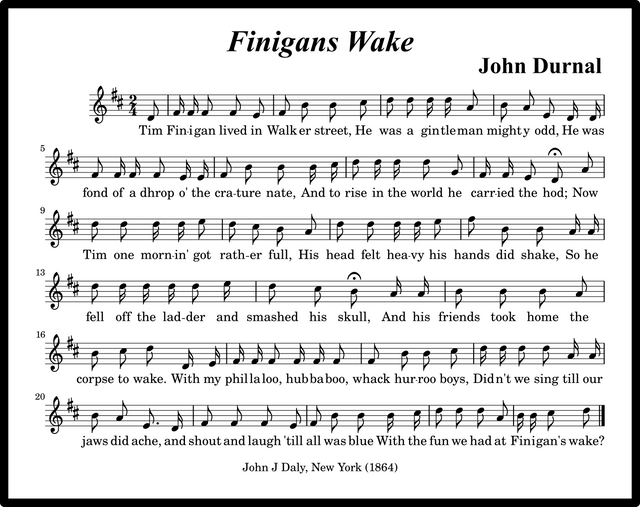
Bryant-Glover Version
The Bryant-Glover Version was published by William A Pond & Company in New York in 1864. The arrangement for pianoforte was made by the English composer Charles William Glover, who had actually died on 23 March 1863. Although there are numerous minor differences between this version and the Durnal Version, they share what is essentially the same tune:
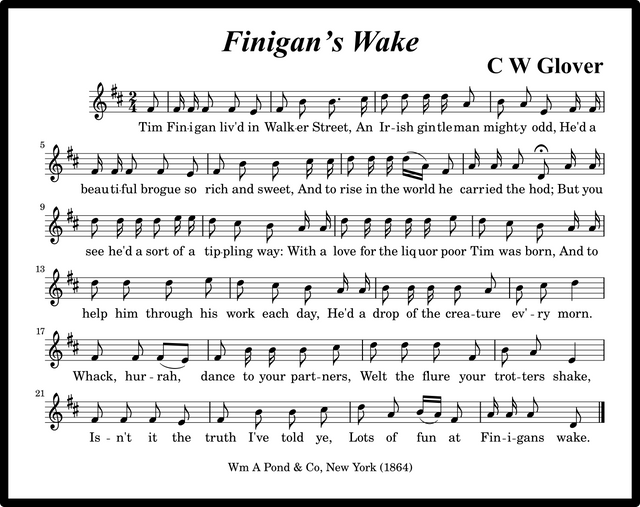
Poole Version
When John F Poole’s song Tim Finigan’s Wake appeared in Tony Pastor’s Book of Six Hundred Comic Songs and Speeches in 1867, no music was printed. Instead, the song bore the rubric: Air—“The French Musician”. According to the Folk Music index, this is the same as Doran’s Ass, and it is sufficiently different from the melody of the Durnal and Bryant-Glover Versions that Keefer distinguishes the two as Finnegan’s Wake - I and Finnegan’s Wake - II.
The French Musician and Doran’s Ass are the names given to the tune that appears under the title Finnegan’s Wake in O’Neill’s Irish Music (p 352), which was published in Chicago in 1903. Francis O’Neill was an Irish cop with a passion for Irish and Irish-American music. His opus magnum contains 1850 pieces. Finnigan’s Wake, as he calls it, is No 265. Only the melody is given, and it is clearly not the same as the melody of the Durnal or Bryant-Glover Version of 1864. But it does closely resemble another traditional tune, The Spanish Lady.
O’Neill only gives two periods of eight bars each. That’s enough music for a stanza of Finnegan’s Wake, but what about the chorus? In the Durnal and Bryant-Glover Versions, the chorus closely resembles the first period, so perhaps O’Neill’s first period could be repeated after the second, generating the familiar ABA structure.
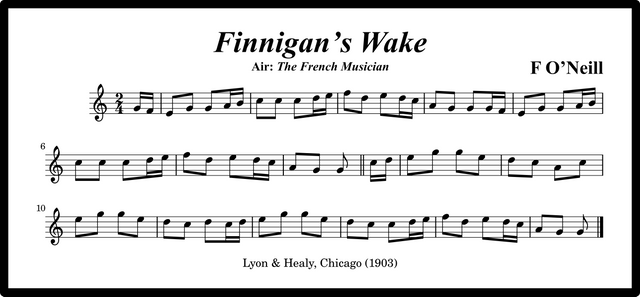
Note that O’Neill’s music is in C-major, but both periods end on the dominant G. I cannot say with any certainty that this is the melody Tony Pastor used when he sang Tim Finigan’s Wake in the 1860s. It is difficult to see how Poole’s lyrics could be fitted to O’Neill’s music:
There is no doubt that of these two versions of Finnegan’s Wake, the Durnal-Bryant-Glover Version more closely resembles the melody which is usually heard today, while O’Neill’s melody is much closer to The Spanish Lady. Here, again, is a famous rendition of Finnegan’s Wake by The Dubliners, with the legendary Ronnie Drew on lead vocals:
The Dubliners: Finnegan’s Wake
This is my attempt at transcribing Ronnie Drew’s inimitable rendition:
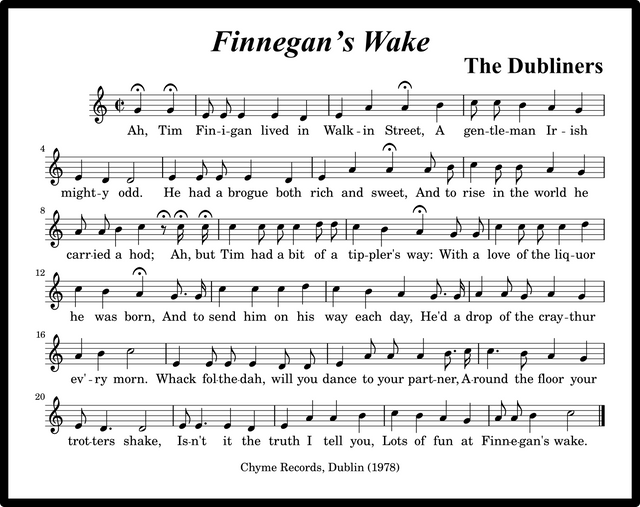
Structure of the Music
The music of Finnegan’s Wake has a tripartite structure: ABA. Each stanza comprises two quatrains. These are then followed by the chorus, which is also a quatrain. Each of the three quatrains is set to its own musical period of eight measures. The first and third periods are essentially the same, while the second period provides some contrast. Each period subdivides into two phrases of four bars each.
In the context of Joyce’s Finnegans Wake, this tripartite structure is particularly apt. It echoes the terza rima of Dante’s Divine Comedy and the division of that work into three cantos. It also reflects the three ages of Vico’s philosophy of history.
Reduced to its bare bones, the melody is as follows:
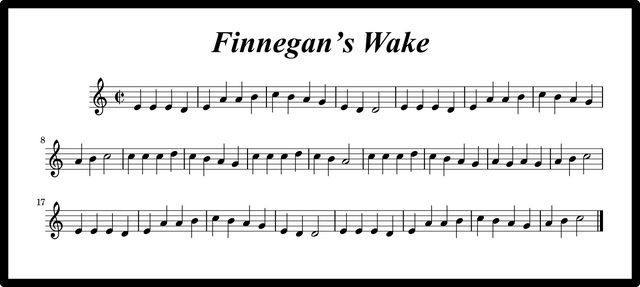
The tune is simple and elegant. One is reminded of Haydn’s Emperor’s Hymn or Beethoven’s Ode to Joy, both of which have the same melodic simplicity, with an emphasis on conjunct motion and diatonic notes. And like Finnegan’s Wake, each of those masterpieces has a musical pedigree going back at least a century.
It is instructive to compare the outline of Finnegan’s Wake with The Spanish Lady, a melody that is often mentioned in connection with the origins of the former:
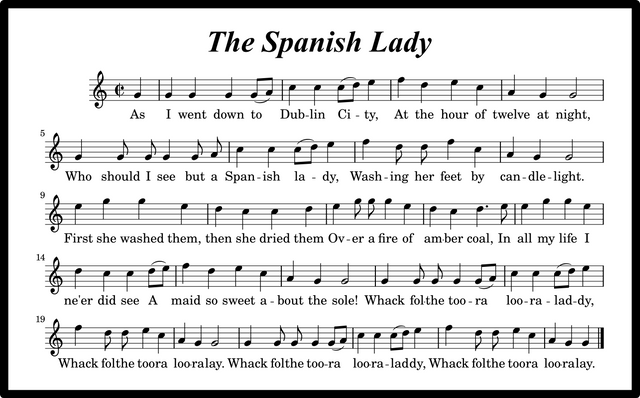
Both melodies have similar ABA structures, with three periods of eight bars each, and each period comprising two phrases of four bars. Their melodic contours are also quite similar, but they are not so close that one could be considered a variation of the other. The Spanish Lady was probably one of several pieces that influenced the evolution of Finnegan’s Wake, but that is as far as one can go.
The history of The Spanish Lady is every bit as obscure as that of Finnegan’s Wake. It is certainly much older than the latter, with versions of the song appearing in the late 17th or early 18th century in both Ireland and England (Shepard). But to try and trace it back to its origins would take us too far out of our course. This musical digression has dragged on long enough as it is.
References
- James Joyce, Finnegans Wake, The Viking Press, New York (1958, 1966)
- Francis O’Neill (editor), James O’Neill (arranger), O’Neill’s Music of Ireland, Lyon & Healy, Chicago (1903)
- Tony Pastor, Tony Pastor’s Book of Six Hundred Comic Songs and Speeches, Dick & Fitzgerald, New York (1867)
- Danis Rose, John O’Hanlon, The Restored Finnegans Wake, Penguin Classics, London (2012)
- Leslie Shepard: The Broadside Ballad: A Study in Origins and Meaning, Herbert Jenkins Ltd, London (1962)
Video Credits
- The Dubliners: Finnegan’s Wake, Standard YouTube License, The Dubliners: 20 Original Greatest Hits, Chyme Records, Dublin (1978), Fair Use
Image Credits
- The Dubliners (1970): © Press Association, Fair Use
- Tim Finigan’s Wake: Tony Pastor’s Book of Six Hundred Comic Songs and Speeches, Public Domain
Useful Resources
- The Traditional Tune Archive
- The Folk Music Index
- Joyce Tools
- FWEET
- The James Joyce Scholars’ Collection
- FinnegansWiki
- Annotated Finnegans Wake (with Wakepedia)

Very good tune is. Dude i miss you...
Excellent story certainly made a good music thank you for letting us know about them great friend greetings
the funny hairstyles are shown in the picture:)